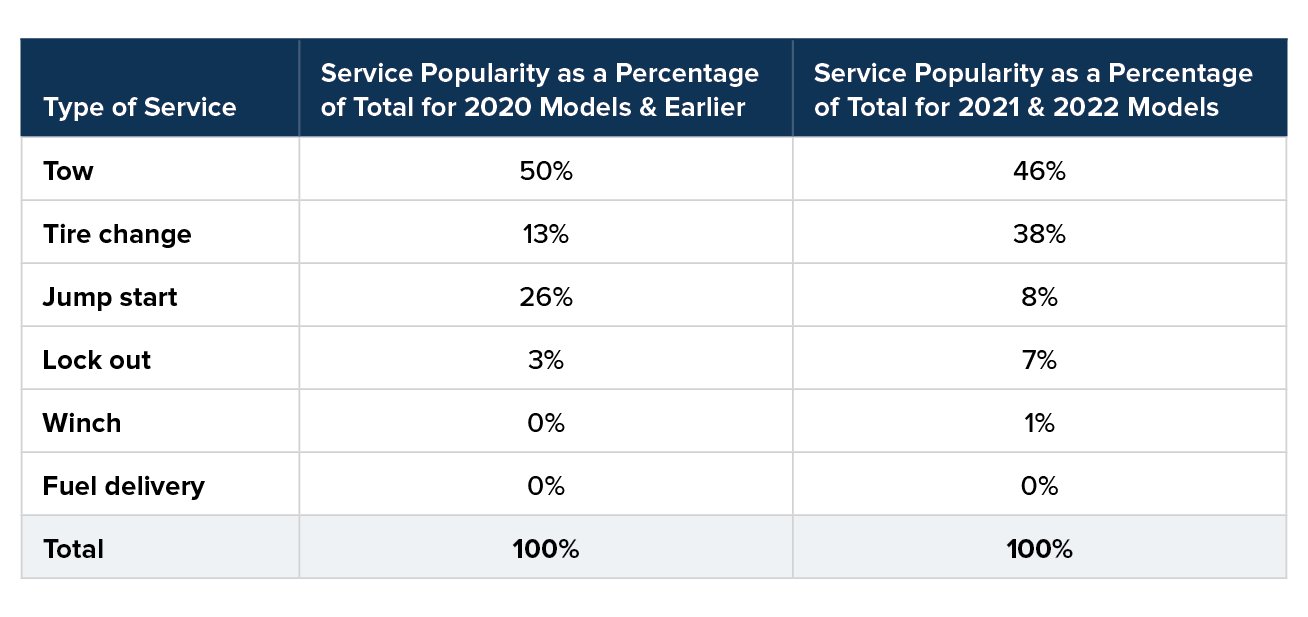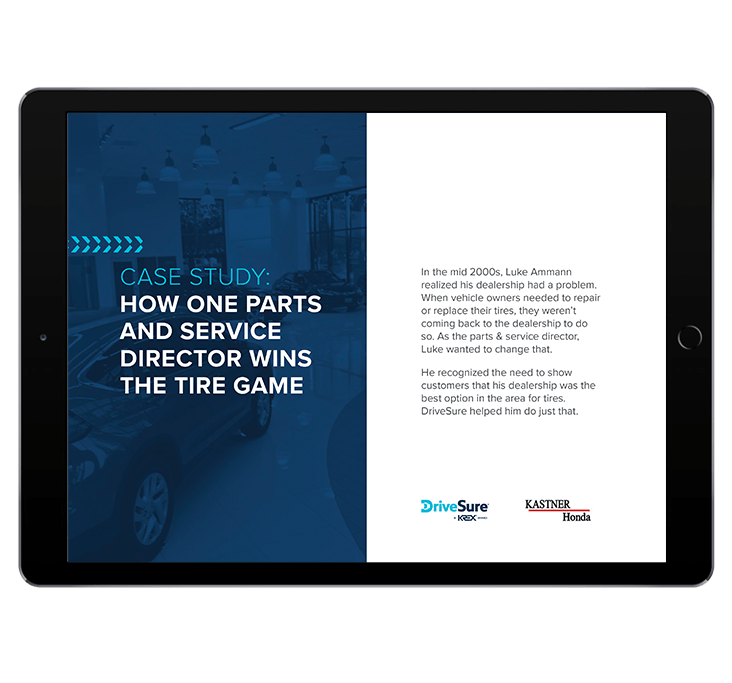We all know that as a vehicle ages, it’s increasingly likely that a vehicle owner will take it to an aftermarket repair shop rather than the dealership. But did you know that how your dealership approaches tires may be driving new-car owners away too?
There are two reasons for this:
- The newer the vehicle, the more likely it is that any problems will be related to tires.
- In general, dealerships struggle to effectively connect with their customers on tire-related issues and services.
Before we explore how to overcome these challenges, let’s break them down a bit further.
Why Tires Are a Major Defection Point for New-Car Owners
We recently ran a study on our data for roadside assistance requests (broken down by model year) for one of our dealer groups. We found that while there are fewer roadside assistance requests for newer vehicles, the proportion of calls for tire changes is higher. In short, when a newer vehicle has an issue, it’s more likely that issue will be related to tires.

This raises a problem: if the vehicle owner doesn’t think of your dealership as a place to get tires repaired or replaced, they’re likely to go elsewhere. As soon as they step foot in another shop, you run the risk of never seeing them again. That shop gets a chance to win them over with a high-quality experience, more attractive pricing, and/or ongoing marketing efforts – it’s a risk you don’t have to take if the customer comes back to your service lane instead.
Unfortunately, we know that vehicle owners often don’t think of your dealership as a place to get tires repaired or replaced. In our last survey of dealership service customers, 24% weren’t even sure if their dealership sold tires and 69% had purchased their last set of tires somewhere else.
In addition, dealerships often struggle when customers do come to them for tires. There’s a common misconception among vehicle owners that can damage your relationship with them: recent buyers often assume their warranty will cover tire damage due to road hazards. This misunderstanding leads to frustration when they learn this isn’t true – causing a negative experience that could cost you that customer for life.
Luckily, there’s a lot your dealership can do to overcome these issues.
Learn how one parts & service director won back tire business for his dealership.
How to Get Customers Thinking About Your Dealership for Tires
As we highlighted from our survey results above, less than a third vehicle owners that service their vehicles at dealerships also buy their tires from dealerships.
Improving customer loyalty only goes so far to address this — even for customers who said they were “extremely loyal” to their servicing dealership, less than half of them (48%) had purchased their last set of tires there and 20% of them didn’t even know if their dealership sold tires.
It’s clear that dealerships have some work to do to better educate customers about tire offerings.
Some of the things you can do here are simple. Including more mentions of tires in your marketing and ensuring tire displays are front and center in your service check-in, waiting, and/or check-out areas can be great first steps if you’re not doing these things already.
We’d encourage you to go further to find unique ways to offer additional value around tires. For example, the Road Hazard Tire Protection included in DriveSure’s suite of renewable benefits allows you to provide complimentary tire repairs and replacement, exclusively at your dealership. This drives customers back to you whenever they have tire issues, and keeps your dealership top-of-mind when they’re ready for routine tire replacements.
For example, the Road Hazard Tire Protection included in DriveSure’s suite of renewable benefits allows you to provide complimentary tire repairs and replacement, exclusively at your dealership. This drives customers back to you whenever they have tire issues, and keeps your dealership top-of-mind when they’re ready for routine tire replacements.
How to Overcome Tire Warranty Confusion and Disappointment
As we discussed, even with customers do come to your dealership due to a damaged tire, they often incorrectly assume it will be covered by their warranty.
How do you avoid this? When making the initial sale, you should take the opportunity to be transparent with the buyer. Manage expectations and inform them if tire repairs are not covered under factory warranty. This transparency helps build much-needed trust with your customers.
However, bear in mind that in the rush to get done with the paperwork, new car buyers tend to forget a lot of the details you tell them in these moments. In other words, you still run the risk of them being shocked when they return for a repair and find out it’s not covered by warranty.
To prevent important information getting lost in the details, you may want to keep it simple and just explain the recommended service schedule for tire service (which has become more frequent than oil changes). You may also want to consider a digital reminder campaign, such as emails or text messages.
Offering a program like DriveSure is another way to overcome this issue. With the road hazard tire protection included in customers’ benefits, you can still cover the repair or replacement for the customer even if their warranty doesn’t. This same renewable benefit incentivizes the customer to return for scheduled maintenance to automatically renew their coverage.
At the end of the day, keeping as many of your customers as possible means getting them to come back to you for all things tires and making sure they’re happy they did. Consistent and transparent communications about tire offerings and coverage are a great place to star. And if you want to truly win the tire game and maximize profits, tire related value-add programs like DriveSure can put you on top.
CASE STUDY
Are you missing out on tire revenue?
Learn how one Parts & Service Director won back tire business for his dealership.


